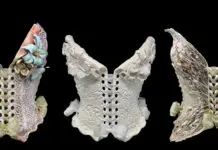Green Country beekeeper Helen Hickey has been interested in bees for more than 12 years.
For Hickey, beekeeping is more than just “going green.” For her, beekeeping is a way to take care of the environment and every living thing in it – down to the smallest bee.
Oklahoma Magazine: What is your interest in beekeeping?
Helen Hickey: As an organic gardener, in the early ‘90s, I noticed there weren’t many bees pollinating my vegetables. I took a beekeeping class, and after a couple of years of using chemicals as instructed, my husband and I chose to keep bees naturally or not at all. We were told it couldn’t be done. I also keep bees naturally so I can enjoy a healthy source of honey with pollen still in it. Small doses of pollen work like allergy shots for me.
OM: Since becoming a beekeeper, you’ve taught many classes and conducted lectures around Green Country about the world’s bees disappearing.
HH: My husband and I feel we have a mission to educate others to the seriousness of the problem. I became a master gardener to speak to the public and children in our schools about the threat to bees. Einstein once said that if bees disappear, then man will also. He knew that most of the food consumed by man must be pollinated, and most of that pollination is done by bees. About a third of human food requires pollination. Some plants simply cannot grow without it.
OM: So what is causing the bees to disappear?
HH: Scientists have labeled it colony collapse disorder. CCD is a phenomenon in which worker bees abruptly disappear. CCD is thought to be caused by multiple problems. Bees forage over several miles and often bring back to the hive herbicides and pesticides in the pollen and nectar. Sometimes the bees die from exposure, or often end up weakening the hive by contaminating it. A weakened hive is susceptible viruses, pathogens and parasites. So, it can be complicated problem.
OM: You’ve worked as a microbiologist, chemist and epidemiologist; how has this knowledge been used in your beekeeping?
HH: I’ve researched the causes of infections, so I am familiar with how to “grow” organisms that are pathogens to humans. So I decided to research bee diseases and use that knowledge to reverse bee illnesses. This included how to monitor changes in the hive, hygienic practices, and ways to monitor pests.
OM: You described a modification to interior structure of the hive that helps keeps bees healthy. What is this modification, and why is it important?
HH: After a lot of research, my husband and I added a screen to the bottom of our hives so mites, which are detrimental to bees, can fall through. We also used an additional screen to catch the mites to count how many were infecting the hive, and only treated when we had to. We also took out the traditional inner cover, which let moisture drip on the bees in the winter. Warm moisture plus honey equaled bacterial and fungal growth; the new configuration helped eliminate that problem. This modification in the structure of the hive is now widely practiced, but at the time we were told we were crazy.
OM: What are your future plans with your beekeeping?
HH: Future plans include a project in helping refugees from Sudan. We are raising money for scholarships to teach men and women of the country how to making a living through beekeeping and for purchasing needed equipment.
OM: You are very active in your bee club. Why is it important for novice beekeepers to get involved?
HH: I feel it is a calling, if you will, to mentor new beekeepers. Our club classes are full, and there is a great interest in backyard beekeeping. We want new beekeepers to be successful so that they can help save the bees and the world, one beehive at a time.

























